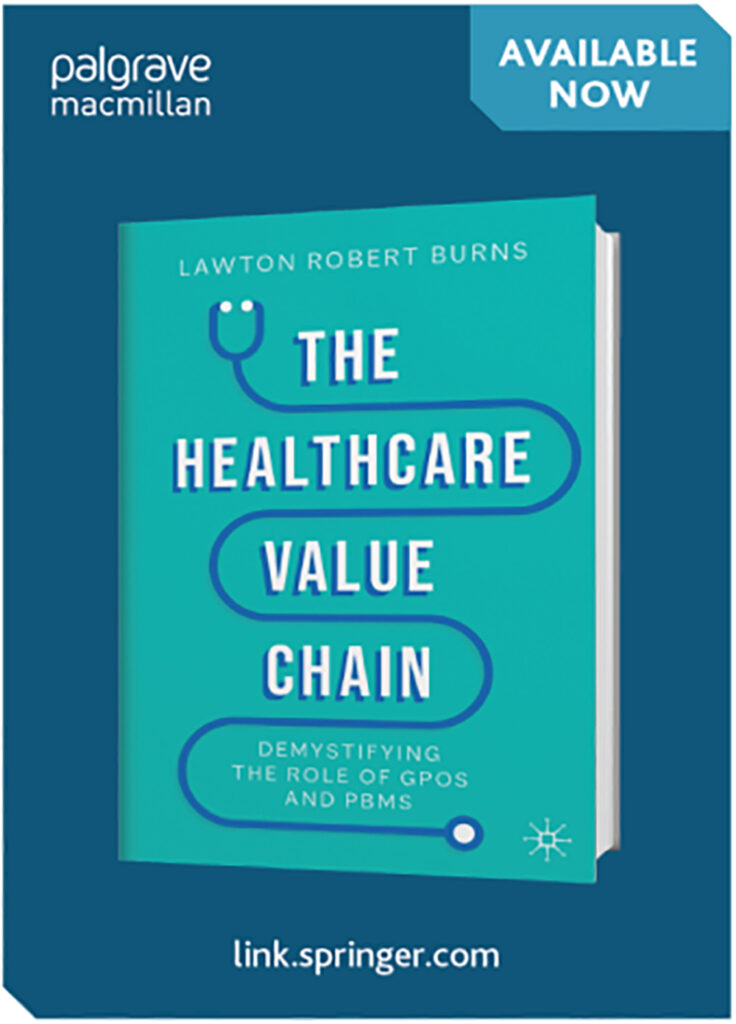How one business professor is on a mission to demystify an important segment of the U.S. healthcare supply chain.
February 2023 – The Journal of Healthcare Contracting

When Lawton Burns, Ph.D., MBA, looked at the literature available for the U.S. healthcare system, he saw a large gap in information and education about group purchasing organizations (GPOs) and pharmacy benefit managers (PBMs).
“I’ll give you an illustration of how frustrating this can be,” said Dr. Burns, professor of Health Care Management at The Wharton School, University of Pennsylvania. “Everybody who talks about the history of GPOs starts with the formation of the Hospital Bureau in 1910. Then they jump to the present day – and miss what happened in the last 110+ years. There is a total gap in everybody’s understanding. I like to tell my students that the only thing new in the world is the history you don’t know.”
Dr. Burns said a good chunk of his recently released book, “The Healthcare Value Chain: Demystifying the Role of GPOs and PBMs,” is the history of GPOs and PBMS that nobody knows. In an interview with The Journal of Healthcare Contracting, Dr. Burns discussed some misconceptions about GPOs and PBMs, and the importance of these two entities in today’s healthcare supply chain.
JHC: Why was it important to write this book? How long has it been brewing?
Dr. Burns: Once you understand the history, you understand not only where these organizations came from, but also how they operate, why they operate, and for whom they’re working. It demystifies the entire field. The subtitle to this book, “Demystifying the Role of GPOs and PBMs”, was a deliberate effort to say these organizations aren’t as dark and mysterious as a lot of people paint them to be.

In 2002, I wrote a book called “The Healthcare Value Chain,” on the relationship between manufacturers, wholesalers, GPOs, and hospitals. That was also the same year that the U.S. Senate held the first of four hearings on GPOs and the same year the New York Times began an investigation of GPOs. All the stuff was negative. I have a chapter in this book on what was brought up in the Senate hearings, and what was brought up in the New York Times articles that debunks a lot of the stuff that surfaced then.
But the GPOs didn’t do a very good job of defending themselves, and there was no written record to set everybody straight. That’s what this book is trying to do. Several years ago I began teaching my MBA students on the PBMs, and then the light went off. I recognized that the PBMs are the retail channel equivalent to the GPOs who operate in the institutional channel. So you have the PBMs operating in the retail channel going to the retailers, and GPOs operating in the institutional channel going to the hospitals and nursing homes, and they play similar roles. I thought there might be something to learn by examining them both.
JHC: In your book, you mention that both organizations are often “cloaked in mystery.” Are GPOs and PBMs misunderstood?
Dr. Burns: The first chapter of my new book is called “Dark Territory”. When you mention GPOs or PBMs, a lot of negative connotations come to mind. There’s a lot of suspicion and mistrust, and I think a lot of unfair allegations. But as I said, there’s no comprehensive treatment of the GPOs or the PBMs in the literature. And in that kind of a void, there are a lot of parties who have an ax to grind, who have written articles and reports that are quite partisan and one-sided, and they’re often written without really understanding what takes place inside of these organizations and who these organizations work for.
I take a great deal of time to explain that the GPOs and the PBMs don’t exist and didn’t arise on their own – they’re “agents” working for other companies who we call “principals”. It’s called the agent-principal relationship. The GPOs are agents working for hospitals, and the PBMs are agents working for the insurance companies. They’re not working for themselves. They were fostered and developed and supported by the people they’re working for.
In general, most people don’t understand what intermediaries do. The other classic intermediaries are the health insurers. Nobody in the public understands what health insurers do except they distrust them and don’t like them. Intermediaries like insurers, GPOs, and PBMs are not well understood. They’re usually blamed for everything that’s bad in the healthcare system. They’re criticized for allegedly taking fees without doing anything or making anything.
They’re also often criticized for taking kickbacks. That’s the loaded word used in the healthcare supply chain. “They’re on the take, taking kickbacks from manufacturers, and they’re out there to serve the manufacturers’ interests.” Now kickbacks have a negative connotation, even though people don’t recognize that these payments that people call kickbacks are permissible under federal statutes for the GPOs. They’re also permissible based on some other rulings for the PBMs, but everybody likes to use the loaded term kickbacks.
JHC: While occupying similar roles, what are some significant ways that GPOs and PBMs are helping shape the supply chain?
Dr. Burns: One thing I hadn’t fully realized until researching this book is that they both started as cooperative organizations. The GPOs were hospital cooperatives trying to save money. The PBMs actually grew out of a lot of the early prepaid medical group HMOs, health maintenance organizations, and they were basically designed to save money for capitated enrollees to save money on the drugs that were being used to treat those patients. So, they both started off as these local consumer cooperatives.
Another way in which they’re similar is that the GPOs negotiate contracts and prices with manufacturers for products that their hospital sponsors use. For their part, the PBMs administer prescription drug plans developed by insurers, help to develop the product formularies, and then negotiate the drug prices with the manufacturers.
So, they’re doing the same thing. Sometimes the GPOs are owned by the hospitals, and increasingly the PBMs are owned by the insurance companies. So the “principal-agent” relationship is changing as these intermediary functions are brought in-house. This clearly shows who these intermediaries are serving. They resemble one another because they’re serving as bargaining agents for the hospitals and the insurers to get lower prices for the products that their members are using.
GPOs are developing contracts for medical/surgical items, medical devices, drugs administered in the hospital, capital equipment, etc. PBMs are negotiating prices and contracts for the retail drugs that the enrollees and the insurance plans are going to use. They’re basically using the same leverage of collective buying or pooled purchasing on behalf of their customers.
Going beyond that, they help with product selection. The GPOs have clinical committees. The PBMs have pharmacy and therapeutics committees, and they’re helping with product selection to help their downstream customers balance two things: they want access to innovative technologies, but at the same time, they don’t want to have to pay list price for it. They’re balancing quality and cost and trying to make trade-offs between those two things.
JHC: Can you describe how these organizations can control costs and improve outcomes?
Dr. Burns: They started as cost control vehicles. Healthcare input costs are pretty high, and they’ve been rising over time. These two organizations use pooled purchasing to get lower input costs by extracting discounts from the product manufacturers. Basically, they’re trading higher volume for a lower price, so it’s a standard economic exchange. “We’ll buy more in bulk from you if you give us a lower price.” It’s like going to Costco.
Secondly, they help to diminish the impact of continued price hikes by the device manufacturers and drug manufacturers. Manufacturers hike their prices multiple times during a year. If you add up all those price hikes on their drugs, that’s quite a big price increment for people downstream to pay.
What the PBMs and GPOs do is essentially mitigate all those price hikes by negotiating them down, such that instead of having a high single or low double-digit price increases, these intermediary organizations help them negotiate net price hikes in the low single digits.
The other thing PBMs and GPOs do to help control costs is earn rebates from the manufacturers, the majority of which they share back with their downstream sponsors, whether it’s the hospitals or the insurance companies, and then the employers. Then it’s up to those organizations to figure out what to do with the savings.
But the GPOs and the PBMs are basically negotiating savings that help the hospitals, insurance companies and employers downstream. I don’t think most people recognize that.
JHC: How would you say they are performing in their respective roles? Are they good or bad for competition?
Dr. Burns: The GPOs have been out there for the last 110 years. I think they’re playing their role really well. But PBMs came along much later. The first one started in the late ’60s, and then they took off in the ’70s and the ’80s. Then both organizations underwent mergers and acquisitions to become big national organizations.
But both parties essentially want to maintain competition among the product manufacturers to keep the product manufacturers honest and say, look, if you jack up your prices too much, there are other product manufacturers out there we might shift our business to. What these intermediaries are trying to do is maintain competition in the product manufacturer market. They’re not out there to serve the product manufacturers. In fact, what these two organizations want is competitive markets so they can extract price discounts and pass them along to their sponsors downstream.
Now, not everybody agrees with that. The PBMs and the GPOs have aggrieved parties who continually complain about them, and you can’t please everybody. The PBMs and GPOs are out there to satisfy hospitals and insurance companies and employers, but there are other stakeholders in the healthcare value chain that feel wronged or disadvantaged by the GPOs and the PBMs. The major party that’s always complained about the GPOs are the small medical device manufacturers. The PBMs have always been criticized by the independent retail pharmacies.
So, some people win, some people lose, and some people feel disadvantaged. Not everybody is in full agreement that GPOs and PBMs play positive roles that everybody ought to champion and support. There are winners and losers in the marketplace, and it’s what we call static efficiency versus allocative efficiency. These organizations make things more efficient, but not everybody is advantaged by them. So, it’s just hard to please everybody. But you know, what else is new?
